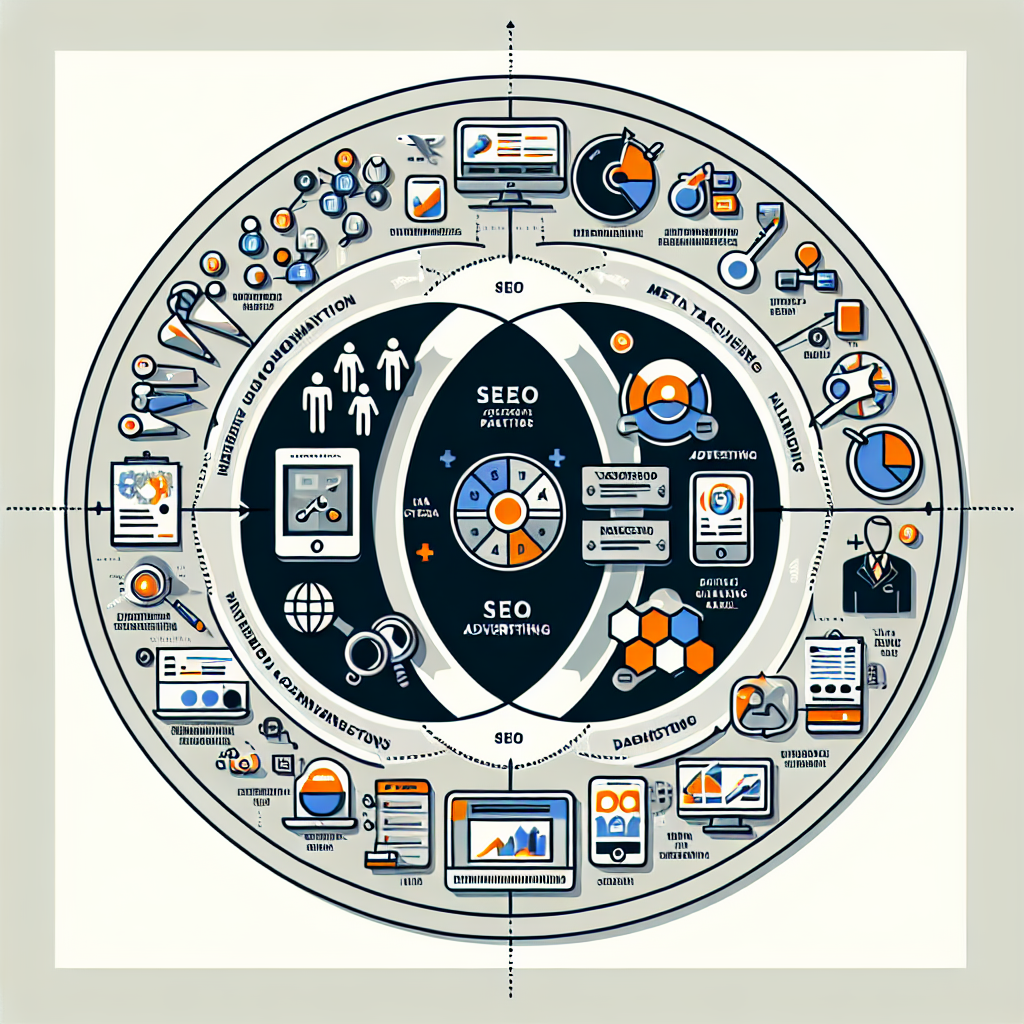
You’ve come to the right place if you’re wondering how to seamlessly incorporate SEO strategies into your advertising campaigns. With the ever-growing importance of digital marketing, it is crucial to have a comprehensive understanding of how search engine optimization can enhance your advertising efforts. In this article, we will explore practical tips and techniques that will help you maximize the visibility and reach of your campaigns while driving organic traffic to your website. So, let’s dive in and discover the secrets to effectively integrating SEO strategies into your advertising campaigns.
Understanding SEO Strategies in Advertising Campaigns
What is SEO?
SEO stands for Search Engine Optimization, which is the practice of improving a website’s visibility and ranking on search engine results pages. It involves various techniques and strategies aimed at increasing organic (non-paid) traffic to a website. By optimizing a website’s content, structure, and HTML code, SEO helps search engines understand and rank it better, resulting in increased visibility and website traffic.
What are Advertising Campaigns?
Advertising campaigns are structured and planned marketing efforts aimed at promoting a specific product, service, or brand. These campaigns typically involve various types of advertisements, such as print, digital, television, or radio commercials, and are designed to reach and influence a target audience. The goal of advertising campaigns is to drive consumer awareness, interest, and ultimately, conversion or action.
Benefits of Integrating SEO Strategies into Advertising Campaigns
Increased Visibility
One of the key benefits of integrating SEO strategies into advertising campaigns is increased visibility. By optimizing your website and content using relevant keywords and search terms, you increase the chances of your website appearing in search engine results. This enhanced visibility ensures that your target audience can easily find your business when searching for related products or services, leading to higher organic traffic and potential conversions.
Cost-Effectiveness
Integrating SEO strategies into advertising campaigns can be a cost-effective approach compared to other forms of advertising. While traditional methods such as print, radio, or TV advertisements often require substantial financial investment, SEO focuses on organic traffic generation. By employing effective SEO techniques, you can attract relevant users without directly paying for ad placements, resulting in long-term savings and a higher return on investment.
Better Targeting
SEO strategies not only improve visibility but also enable better targeting in advertising campaigns. By conducting keyword research and analyzing competitor keywords, you can identify the specific terms and phrases that your target audience is searching for. By incorporating these keywords organically into your website content and advertising copy, you can ensure that your message reaches the right people at the right time. This targeted approach increases the chances of attracting qualified leads and maximizing the effectiveness of your advertising campaigns.

Identifying Target Keywords for Advertising Campaigns
Keyword Research Tools
To effectively integrate SEO strategies into advertising campaigns, it is crucial to identify the most relevant and high-performing target keywords. Keyword research tools such as Google Keyword Planner, SEMrush, and Ahrefs can help you discover popular search terms related to your industry or niche. These tools provide valuable insights into search volume, keyword difficulty, and other essential metrics, enabling you to select the most appropriate keywords for your advertising campaigns.
Analyzing Competitor Keywords
Another effective way to identify target keywords for advertising campaigns is by analyzing competitor keywords. By studying the keywords that your competitors are using and ranking for, you can gain valuable insights into what works well in your industry. Tools like SEMrush and SpyFu allow you to track and analyze your competitors’ keywords, identifying opportunities to optimize your own advertising campaigns and gain a competitive edge.
Optimizing On-Page Elements for SEO in Advertising Campaigns
Title Tags
Title tags play a crucial role in SEO and advertising campaigns. These HTML elements appear as the clickable headline in search engine results and on social media platforms. By including target keywords, relevant information, and a compelling call to action in your title tags, you can not only improve your website’s SEO but also attract users’ attention and encourage clicks. Optimize your title tags to accurately reflect your content and entice users to visit your website.
Meta Descriptions
Meta descriptions are brief summaries that appear beneath the title tag in search engine results. While meta descriptions don’t directly impact search engine rankings, they play a significant role in attracting users and improving click-through rates. Optimize your meta descriptions by including target keywords and crafting compelling, concise, and informative summaries that entice users to click on your website.
Headings
Headings, also known as H1, H2, H3, etc., help structure and organize your website content. These headings not only make it easier for users to navigate your page but also signal to search engines the importance and relevance of specific sections. Incorporate target keywords naturally into your headings to improve SEO and make it easier for users to understand your content at a glance.
URL Structure
Having a clean, concise, and keyword-rich URL structure can positively impact both SEO and advertising campaigns. Search engines and users prefer URLs that are easy to read and understand. Ensure that your URLs contain relevant keywords and accurately reflect the content on the respective page. This optimization enhances both the visibility and usability of your website, making it more attractive to search engines and users alike.

Creating SEO-Friendly Ad Copy
Keyword Placement
Incorporating target keywords into your advertising copy is essential for optimizing your campaigns for SEO. By strategically placing relevant keywords in your headlines, ad text, and call-to-action statements, you increase the chances of your ads appearing in relevant search results. Ensure that your keyword placement is natural and relevant, providing valuable information to users while aligning with your campaign goals.
Compelling and Relevant Content
While keyword placement is crucial, it is equally important to create compelling and relevant content in your advertising campaigns. Your ads should provide relevant information, address users’ pain points, and clearly communicate the unique selling points of your product or service. By offering valuable content and engaging with your target audience, you can increase the click-through rate, conversions, and overall effectiveness of your advertising campaigns.
Leveraging Data Analysis to Optimize Advertising Campaigns
Monitoring Keyword Performance
To effectively optimize advertising campaigns, it is vital to monitor and analyze keyword performance regularly. By tracking the performance of your target keywords, you can identify which keywords are driving the most traffic, conversions, and revenue. This data allows you to make data-driven decisions, optimize your campaigns further, and allocate resources to the most effective keywords, ensuring maximum return on investment.
Analyzing Conversion Rates
In addition to monitoring keyword performance, analyzing conversion rates is crucial for optimizing advertising campaigns. By examining which keywords are generating the highest conversion rates, you can focus your efforts on those keywords and modify underperforming ones. This analysis also helps identify any issues that may be hindering conversions, allowing you to make necessary adjustments and improve the overall effectiveness of your advertising campaigns.
Using Backlinks to Boost SEO in Advertising Campaigns
Building High-Quality Backlinks
Backlinks, or inbound links, are links from other websites that direct users to your website. By acquiring high-quality backlinks from reputable and relevant websites, you can enhance your website’s authority and credibility in the eyes of search engines. Implementing a backlink building strategy as part of your advertising campaigns can significantly boost your SEO efforts and improve your organic visibility.
Guest Blogging
Guest blogging is an effective way to acquire backlinks and increase your website’s exposure. By writing informative and relevant articles for other reputable websites in your industry, you can establish yourself as an expert and gain valuable exposure to a new audience. In return, you can include links back to your website, driving traffic and improving your website’s SEO.
Social Media Engagement
Engaging with your audience on social media platforms not only helps build brand awareness but also generates opportunities for backlinks. By actively participating in relevant discussions, sharing valuable content, and building relationships with influencers and industry experts, you can increase the chances of others linking to your website. Social media engagement can indirectly contribute to your SEO efforts and improve your advertising campaign’s overall effectiveness.
Mobile Optimization for SEO in Advertising Campaigns
Responsive Design
With the increasing prevalence of mobile devices, optimizing your website for mobile users is essential for both SEO and advertising campaigns. Responsive design ensures that your website adapts to different screen sizes and provides an optimal user experience across all devices. By delivering a seamless and mobile-friendly experience, you improve user engagement, minimize bounce rates, and maximize the effectiveness of your advertising campaigns.
Fast Loading Speed
Mobile users expect fast-loading websites, and search engines prioritize websites that provide a smooth user experience. Optimizing your website’s loading speed is vital for both SEO and advertising campaigns. Compressing images, minifying code, and utilizing caching techniques are a few strategies to enhance your website’s loading speed. A fast-loading website not only improves search engine rankings but also reduces user frustration and increases the likelihood of conversions.
Utilizing Social Media for SEO in Advertising Campaigns
Social Sharing Buttons
Integrating social sharing buttons into your website and advertising campaigns can significantly impact your SEO efforts. These buttons encourage users to share your content on their social media platforms, increasing its visibility and potential reach. When others share your content, it generates backlinks, improves brand awareness, and indirectly supports your advertising campaigns. Ensure that social sharing buttons are easily accessible and prominently displayed to encourage users to spread the word about your brand.
Engaging with Followers
Engaging with your social media followers is an effective way to optimize your advertising campaigns for SEO. Responding to comments, questions, and inquiries demonstrates your commitment to providing excellent customer service and building relationships with your audience. This active engagement generates brand loyalty, encourages user-generated content, and increases the likelihood of others sharing your content and linking back to your website. By leveraging social media as part of your advertising campaigns, you can improve your website’s SEO visibility and overall campaign success.
Measuring Success and Making Adjustments
Tracking Metrics
To effectively integrate SEO strategies into advertising campaigns, it is crucial to track and measure the success of your efforts. Key metrics to monitor include organic traffic, conversions, click-through rates, bounce rates, and average session duration. By regularly reviewing and analyzing these metrics, you can identify trends, strengths, and areas for improvement. Utilize web analytics tools like Google Analytics or marketing automation platforms to gain valuable insights into your campaign performance and make data-driven adjustments.
Split Testing
Split testing, also known as A/B testing, involves comparing two or more variations of an ad or landing page to determine which performs better. By testing different headlines, ad copy, images, and calls to action, you can identify the most effective elements for your advertising campaigns. Split testing allows you to make data-driven decisions, optimize your campaigns, and continuously improve your advertising performance over time.
Continuous Improvement
Integrating SEO strategies into advertising campaigns is an ongoing process. To maximize the effectiveness of your campaigns, it is essential to embrace continuous improvement. Regularly review your results, adjust your strategies based on data and insights, and stay updated with the latest SEO trends and best practices. By continuously refining and optimizing your advertising campaigns, you can ensure long-term success and achieve your desired business outcomes.
In conclusion, integrating SEO strategies into advertising campaigns offers a multitude of benefits, including increased visibility, cost-effectiveness, better targeting, and improved campaign performance. By identifying target keywords, optimizing on-page elements, creating SEO-friendly ad copy, leveraging data analysis, utilizing backlinks, optimizing for mobile, and utilizing social media, you can enhance your advertising campaigns’ effectiveness and drive tangible results. Remember to measure success, make adjustments based on data, and continuously improve to stay ahead in the dynamic digital marketing landscape.





